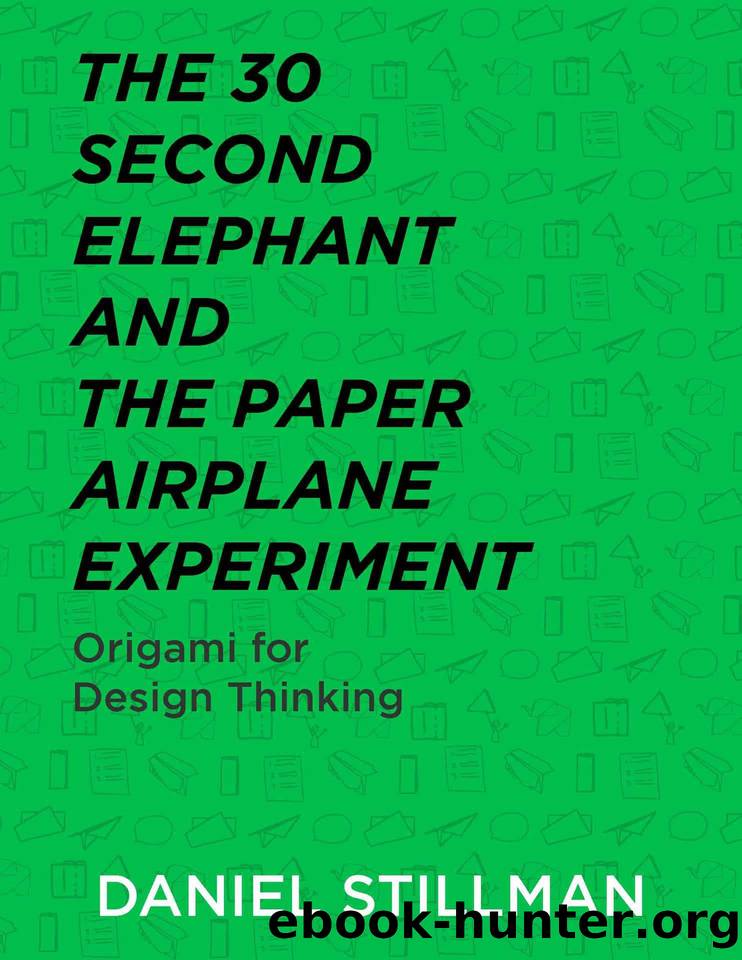The 30 Second Elephant and the Paper Airplane Experiment: Origami for Design Thinking by Stillman Daniel

Author:Stillman, Daniel [Stillman, Daniel]
Language: eng
Format: epub
Publisher: The Conversation Factory
Published: 2018-09-03T16:00:00+00:00
Unfolding the Exercise: Collaborating in Teams
At the end of the ten minutes, almost every team will come up with a different set of instructions for their paper airplane. And many will have a different plane. Their overt goal was to make instructions, and the secret goal of the exercise is to get participants to examine the way they decide on what to make. I want people to examine how they decide, not just how they communicate what they decide.
Weâll get your team to unpack the deeper question of how they make group decisions, but I find starting with the what and getting to the why is easier!
Explaining Your Plane
My first unpacking question is simple: âWhat did you make?â
I want to see what each team did and why. After years of running this experiment, itâs clear that âinstructionsâ must look like numbered steps written down on a piece of paper.
50% of teams that participate in the exercise will create âone-dimensional directions,â meaning they used just words. One person will fold and verbally explain the process to another person, who writes it all down, just like a business analyst recording requirements from a stakeholder.
Some teams will use symbols and diagrams to go along with the written directions, making the communication âtwo-dimensionalâ and removing potential ambiguity with the words.
Occasionally teams will take another approach by creating a series of three-dimensional planes. (These are called step folds, like origami breadcrumbs, and are great for blind origami instruction.) Sometimes people get clever and write their instructions directly on the folded plane. I call that âobject as interface.â Only by exploring the object can you figure out how to fold the plane.
One thing that I have never seen a team do is to pull out the cell phone that everyone has in their pockets and make a video of the entire process. Why? Most people fear that would be breaking the rules. The assumption that directions must be one dimensional and that thinking outside the box would be breaking the rules is so limiting to creative communication!
This goes for designing more than just paper airplanes and paper airplane directions. Itâs the same for designing bridges or businesses, conversations, and communities. Breaking the rules often leads to the most beautifully designed parts of life.
Once Iâve recorded all the ways the teams explored communicating, Iâll ask, âWhy did no one take a video?â Their mouths open a bit and they look collectively towards the ground. No one knows what to say and you can almost hear the inward twinge of âWhy didnât we break the rules?â
One pre-reader of this book pointed out that someone could draw an airplane on paper, cut it out, and be making a âpaper airplaneâ in a very different sense.
There are always unspoken rules and itâs always worth not leaving them unspoken. After all you canât break the rules if you donât know what they are!
This way, we are able to see our natural tendency to stay within the boundaries and not question whatâs possible.
Download
This site does not store any files on its server. We only index and link to content provided by other sites. Please contact the content providers to delete copyright contents if any and email us, we'll remove relevant links or contents immediately.
On Writing A Memoir of the Craft by Stephen King(4848)
The Doodle Revolution by Sunni Brown(4668)
A Simplified Life by Emily Ley(4080)
Mummy Knew by Lisa James(3620)
Marijuana Grower's Handbook by Ed Rosenthal(3606)
Better Homes and Gardens New Cookbook by Better Homes & Gardens(3509)
Figure Drawing for Artists by Steve Huston(3362)
Paper Parties by Erin Hung(3354)
Draw Your Day by Samantha Dion Baker(3258)
The Genius of Japanese Carpentry by Azby Brown(3209)
Japanese Design by Patricia J. Graham(3098)
The Code Book by Simon Singh(3057)
Dangerous Girls by Haas Abigail(2956)
Lions and Lace by Meagan Mckinney(2911)
The Curated Closet by Anuschka Rees(2897)
How to Make Your Own Soap by Sally Hornsey(2812)
The Checklist Manifesto by Atul Gawande(2763)
The Wardrobe Wakeup by Lois Joy Johnson(2717)
Zero to Make by David Lang(2716)
